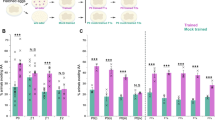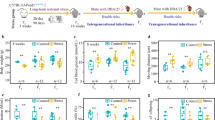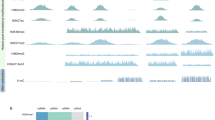Abstract
Using olfactory molecular specificity, we examined the inheritance of parental traumatic exposure, a phenomenon that has been frequently observed, but not understood. We subjected F0 mice to odor fear conditioning before conception and found that subsequently conceived F1 and F2 generations had an increased behavioral sensitivity to the F0-conditioned odor, but not to other odors. When an odor (acetophenone) that activates a known odorant receptor (Olfr151) was used to condition F0 mice, the behavioral sensitivity of the F1 and F2 generations to acetophenone was complemented by an enhanced neuroanatomical representation of the Olfr151 pathway. Bisulfite sequencing of sperm DNA from conditioned F0 males and F1 naive offspring revealed CpG hypomethylation in the Olfr151 gene. In addition, in vitro fertilization, F2 inheritance and cross-fostering revealed that these transgenerational effects are inherited via parental gametes. Our findings provide a framework for addressing how environmental information may be inherited transgenerationally at behavioral, neuroanatomical and epigenetic levels.
This is a preview of subscription content, access via your institution
Access options
Subscribe to this journal
Receive 12 print issues and online access
$209.00 per year
only $17.42 per issue
Buy this article
- Purchase on Springer Link
- Instant access to full article PDF
Prices may be subject to local taxes which are calculated during checkout






Similar content being viewed by others
Change history
09 December 2013
In the version of this article initially published online, the base grant to the Yerkes National Primate Research Center was omitted from the Acknowledgments. The error has been corrected for the print, PDF and HTML versions of this article.
References
Jirtle, R.L. & Skinner, M.K. Environmental epigenomics and disease susceptibility. Nat. Rev. Genet. 8, 253–262 (2007).
Anway, M.D. Epigenetic transgenerational actions of endocrine disruptors and male fertility. Science 308, 1466–1469 (2005).
Weaver, I.C.G. Epigenetic programming by maternal behavior and pharmacological intervention. Nature versus nurture: let's call the whole thing off. Epigenetics 2, 22–28 (2007).
Franklin, T.B. et al. Epigenetic transmission of the impact of early stress across generations. Biol. Psychiatry 68, 408–415 (2010).
Dietz, D.M. et al. Paternal transmission of stress-induced pathologies. Biol. Psychiatry 70, 408–414 (2011).
Morgan, H.D., Sutherland, H.G., Martin, D.I. & Whitelaw, E. Epigenetic inheritance at the agouti locus in the mouse. Nat. Genet. 23, 314–318 (1999).
Carone, B.R. et al. Paternally induced transgenerational environmental reprogramming of metabolic gene expression in mammals. Cell 143, 1084–1096 (2010).
Ng, S.-F. et al. Chronic high-fat diet in fathers programs β-cell dysfunction in female rat offspring. Nature 467, 963–966 (2010).
Crews, D. et al. Transgenerational epigenetic imprints on mate preference. Proc. Natl. Acad. Sci. USA 104, 5942–5946 (2007).
Kaati, G., Bygren, L.O. & Edvinsson, S. Cardiovascular and diabetes mortality determined by nutrition during parents' and grandparents' slow growth period. Eur. J. Hum. Genet. 10, 682–688 (2002).
Rakyan, V.K. et al. Transgenerational inheritance of epigenetic states at the murine Axin(Fu) allele occurs after maternal and paternal transmission. Proc. Natl. Acad. Sci. USA 100, 2538–2543 (2003).
Morgan, C.P. & Bale, T.L. Early prenatal stress epigenetically programs dysmasculinization in second-generation offspring via the paternal lineage. J. Neurosci. 31, 11748–11755 (2011).
Harris, A. & Seckl, J. Glucocorticoids, prenatal stress and the programming of disease. Horm. Behav. 59, 279–289 (2011).
Meaney, M.J., Szyf, M. & Seckl, J.R. Epigenetic mechanisms of perinatal programming of hypothalamic-pituitary-adrenal function and health. Trends Mol. Med. 13, 269–277 (2007).
Rodgers, A.B., Morgan, C.P., Bronson, S.L., Revello, S. & Bale, T.L. Paternal stress exposure alters sperm microRNA content and reprograms offspring HPA stress axis regulation. J. Neurosci. 33, 9003–9012 (2013).
Buck, L. & Axel, R. A novel multigene family may encode odorant receptors: a molecular basis for odor recognition. Cell 65, 175–187 (1991).
Ressler, K.J., Sullivan, S.L. & Buck, L.B. A zonal organization of odorant receptor gene expression in the olfactory epithelium. Cell 73, 597–609 (1993).
Mombaerts, P. Molecular biology of odorant receptors in vertebrates. Annu. Rev. Neurosci. 22, 487–509 (1999).
Jones, S.V., Choi, D.C., Davis, M. & Ressler, K.J. Learning-dependent structural plasticity in the adult olfactory pathway. J. Neurosci. 28, 13106–13111 (2008).
Bozza, T., Feinstein, P., Zheng, C. & Mombaerts, P. Odorant receptor expression defines functional units in the mouse olfactory system. J. Neurosci. 22, 3033–3043 (2002).
Ressler, K.J., Sullivan, S.L. & Buck, L.B. Information coding in the olfactory system: evidence for a stereotyped and highly organized epitope map in the olfactory bulb. Cell 79, 1245–1255 (1994).
Vassalli, A., Rothman, A., Feinstein, P., Zapotocky, M. & Mombaerts, P. Minigenes impart odorant receptor-specific axon guidance in the olfactory bulb. Neuron 35, 681–696 (2002).
Davis, M., Falls, W.A., Campeau, S. & Kim, M. Fear-potentiated startle: a neural and pharmacological analysis. Behav. Brain Res. 58, 175–198 (1993).
Hebb, A.L.O., Zacharko, R.M., Gauthier, M. & Drolet, G. Exposure of mice to a predator odor increases acoustic startle but does not disrupt the rewarding properties of VTA intracranial self-stimulation. Brain Res. 982, 195–210 (2003).
Weaver, I.C.G., Meaney, M.J. & Szyf, M. Maternal care effects on the hippocampal transcriptome and anxiety-mediated behaviors in the offspring that are reversible in adulthood. Proc. Natl. Acad. Sci. USA 103, 3480–3485 (2006).
Weinstock, M. Intrauterine factors as determinants of depressive disorder. Isr. J. Psychiatry Relat. Sci. 47, 36–45 (2010).
Champagne, F.A. & Meaney, M.J. Stress during gestation alters postpartum maternal care and the development of the offspring in a rodent model. Biol. Psychiatry 59, 1227–1235 (2006).
Lomvardas, S. et al. Interchromosomal interactions and olfactory receptor choice. Cell 126, 403–413 (2006).
Magklara, A. et al. An epigenetic signature for monoallelic olfactory receptor expression. Cell 145, 555–570 (2011).
Cedar, H. & Bergman, Y. Linking DNA methylation and histone modification: patterns and paradigms. Nat. Rev. Genet. 10, 295–304 (2009).
van der Heijden, G.W. et al. Sperm-derived histones contribute to zygotic chromatin in humans. BMC Dev. Biol. 8, 34 (2008).
Brykczynska, U. et al. Repressive and active histone methylation mark distinct promoters in human and mouse spermatozoa. Nat. Struct. Mol. Biol. 17, 679–687 (2010).
Rassoulzadegan, M. et al. RNA-mediated non-mendelian inheritance of an epigenetic change in the mouse. Nature 441, 469–474 (2006).
Stickrod, G., Kimble, D.P. & Smotherman, W.P. In utero taste/odor aversion conditioning in the rat. Physiol. Behav. 28, 5–7 (1982).
Hales, C.N. & Barker, D.J. The thrifty phenotype hypothesis. Br. Med. Bull. 60, 5–20 (2001).
Storm, J.J. & Lima, S.L. Mothers forewarn offspring about predators: a transgenerational maternal effect on behavior. Am. Nat. 175, 382–390 (2010).
Todrank, J., Heth, G. & Restrepo, D. Effects of in utero odorant exposure on neuroanatomical development of the olfactory bulb and odour preferences. Proc. Biol. Sci. 278, 1949–1955 (2011).
Skinner, M.K. What is an epigenetic transgenerational phenotype? F3 or F2. Reprod. Toxicol. 25, 2–6 (2008).
Guerrero-Bosagna, C., Settles, M., Lucker, B. & Skinner, M.K. Epigenetic transgenerational actions of vinclozolin on promoter regions of the sperm epigenome. PLoS ONE 5, e13100 (2010).
Vassoler, F.M., White, S.L., Schmidt, H.D., Sadri-Vakili, G. & Pierce, R.C. Epigenetic inheritance of a cocaine-resistance phenotype. Nat. Neurosci. 16, 42–47 (2012).
Roth, T.L., Lubin, F.D., Funk, A.J. & Sweatt, J.D. Lasting epigenetic influence of early-life adversity on the BDNF Gene. Biol. Psychiatry 65, 760–769 (2009).
Greer, E.L. et al. Transgenerational epigenetic inheritance of longevity in Caenorhabditis elegans. Nature 479, 365–371 (2011).
Rechavi, O., Minevich, G. & Hobert, O. Transgenerational inheritance of an acquired small RNA-based antiviral response in C. elegans. Cell 147, 1248–1256 (2011).
Cavalli, G. & Paro, R. Epigenetic inheritance of active chromatin after removal of the main transactivator. Science 286, 955–958 (1999).
Maruniak, J.A., Silver, W.L. & Moulton, D.G. Olfactory receptors respond to blood-borne odorants. Brain Res. 265, 312–316 (1983).
Vanderhaeghen, P., Schurmans, S., Vassart, G. & Parmentier, M. Specific repertoire of olfactory receptor genes in the male germ cells of several mammalian species. Genomics 39, 239–246 (1997).
Oakberg, E.F. Duration of spermatogenesis in the mouse and timing of stages of the cycle of the seminiferous epithelium. Am. J. Anat. 99, 507–516 (1956).
Fleischmann, A. et al. Mice with a “monoclonal nose”: perturbations in an olfactory map impair odor discrimination. Neuron 60, 1068–1081 (2008).
Glinka, M.E. et al. Olfactory deficits cause anxiety-like behaviors in mice. J. Neurosci. 32, 6718–6725 (2012).
Jovanovic, T. et al. Physiological markers of anxiety are increased in children of abused mothers. J. Child Psychol. Psychiatry 52, 844–852 (2011).
Ostermeier, G.C., Wiles, M.V., Farley, J.S. & Taft, R.A. Conserving, distributing and managing genetically modified mouse lines by sperm cryopreservation. PLoS ONE 3, e2792 (2008).
Umlauf, D., Goto, Y. & Feil, R. Site-specific analysis of histone methylation and acetylation. Methods Mol. Biol. 287, 99–120 (2004).
Krueger, F. & Andrews, S.R. Bismark: a flexible aligner and methylation caller for Bisulfite-Seq applications. Bioinformatics 27, 1571–1572 (2011).
Li, H. et al. 1000 Genome Project Data Processing Subgroup. The sequence alignment/map (SAM) format and SAMtools. Bioinformatics 52, 2078–2079 (2009).
Acknowledgements
We would like to thank the animal care staff in the Yerkes Neuroscience Vivarium for assistance with animal husbandry. A. Magklara, S. Lomvardas, B. Carone, O. Rando and A.F.H.M. Peters provided invaluable input on the ChIP experiments. We would like to thank H. Zhang and the staff of the Emory Transgenic Mouse/Gene Targeting Core Facility for assistance with IVF studies. Bisulfite conversion of sperm DNA and sequencing was carried out by Active Motif and we especially thank P. Labhart for addressing our data interpretation queries. Finally, we are grateful to S. Banerjee, R. Andero-Gali, D. Choi, J. Goodman and F. Morrison for help with ensuring double-blindness of data acquisition and analysis, and members of the Ressler laboratory, S. Gourley and M. Davis for helpful feedback on the manuscript. Funding for this study was provided by the Howard Hughes Medical Institute and the Burroughs Wellcome Fund to K.J.R., and a US National Institutes of Health NCRR base grant (P51RR00-0165) to Yerkes National Primate Research Center.
Author information
Authors and Affiliations
Contributions
B.G.D. conceived of the project, designed and performed experiments, analyzed the data, and wrote the paper. K.J.R. obtained funds, designed experiments, analyzed the data, wrote the paper and supervised the project.
Corresponding authors
Ethics declarations
Competing interests
The authors declare no competing financial interests.
Integrated supplementary information
Supplementary Figure 1 Experimental design to investigate the effect of cue-specific trauma to an F0 generation on subsequently conceived generations.
Novel experimental paradigm that uses olfactory fear conditioning to examine the structural and functional changes in the nervous systems of adult mice (F1 and F2) conceived after the F0 generation was trained to associate specific odorant presentations with mild foot-shocks. Briefly, F0 adult male mice were trained to associate Acetophenone or Propanol presentation with mild-footshocks (5 odor-shock pairings/session, 3 sessions, 1 session/day). Ten days after this conditioning, these F0 males were mated with naïve females. Ten days after the mating was setup, the F0 males were separated from the females. F1 offspring born were tested at 2-months of age. For studies of the F2 generation, F1 males that had no previous exposure to either Acetophenone or Propanol were mated with naïve females for 10 days, and resulting F2 offspring were used for analyses. Our experimental design minimized the possibility of a “social transmission” mode of information transfer. Specifically, the F0 male has absolutely no contact with the F1 offspring, is placed with the female 10 days after the last conditioning day, should not have any trace of the conditioned odor on his skin or hair to transfer to the mother, and is separated from the female after a 10 day period to minimize any in utero exposure of the pups to the conditioned male.
Supplementary Figure 2 No differences found in anxiety measures in adult male offspring that had been conceived after the F0 generation males had been subjected to olfactory fear conditioning with acetophenone or propanol.
C57Bl/6J (a) and M71-LacZ (b) adult male offspring (F1-Home, F1-Ace, F1-Prop) spend the same amount of time in the closed and open arms of an elevated plus maze, and make the same number of entries into the open arms. (C57Bl/6J: F1-Home-C57 n = 9 vs F1-Ace-C57 n = 8) (F1-Home-M71 n =11 vs F1-Ace-M71 n =12 vs F1-Prop-M71 n =11) (Two-way ANOVA: p > 0.05 in both experiments).
Supplementary Figure 3 No differences in auditory fear conditioning in adult male offspring that had been conceived after the F0 generation males had been subjected to olfactory fear conditioning with acetophenone or propanol.
No significant differences were found between F1-Home-C57, and F1-Ace-C57 in the acquisition (a), consolidation (b), and extinction retention (c) of the memory of an aversive auditory cue after they were trained to associate 6kHz tone presentations with mild-footshocks. (C57Bl/6J: F1-Home-C57 n = 9 vs F1-Ace-C57 n = 9) p > 0.05 in all experiments.
Supplementary Figure 4 Cross-fostering study to determine transmission versus inheritance of observed effects.
Sexually naïve C57Bl/6J female mice were conditioned with Acetophenone or left in their Home Cage; they were then mated with C57Bl/6J males for 10 days. Offspring were then divided into the following groups: Offspring of Home Cage Mothers (F1-Home-C57), Offspring of Acetophenone Conditioned Mothers (F1-Ace-C57), O-MHC cross fostered starting at P1 by Mothers Conditioned to Acetophenone (F1-Home-C57fostered), O-MCA cross fostered by Home Cage Mothers (F1-Ace-C57fostered).
Supplementary Figure 5 Bisulfite sequencing around the Olfr151 and Olfr6 genes was conducted to query the methylation status of CpG di-nucleotides.
Coding sequences (red text) of Olfr6 and Olfr151 in reverse complement with primers used to generate amplicons highlighted in blue. CpG di-nucleotides shown in Fig. 6 are numbered. The CpG di-nucleotides not numbered in Olfr151 could not be queried due to technical issues.
Supplementary Figure 6 Methylation status of CpG di-nucleotides in the Olfr151 (M71) gene in MOE DNA of the odor naive F1 and F2 generations.
(a) Bisulfite sequencing data to query the methylation status of CpG di-nucleotides in the Olfr151 (M71) gene in MOE of the F1 generation male reveals no differences in methylation between groups (p > 0.05) (n = 4/group). (b) Bisulfite sequencing data to query the methylation status of CpG di-nucleotides in the Olfr151 (M71) gene in MOE of the F1 generation reveals no differences in methylation at individual CpG sites between groups. (c) Bisulfite sequencing data to query the methylation status of CpG di-nucleotides in the Olfr151 gene in MOE of the F2 generation reveals no differences in methylation status between F2-Ace and F2-Prop (n = 4/group) across all CpG di-nucleotides queried (p > 0.05). (d) Bisulfite sequencing data to query the methylation status of CpG di-nucleotides in the Olfr151 gene in MOE of the F2 generation reveals no differences in methylation status between F2-Ace and F2-Prop across specific CpG di-nucleotides queried (Bonferroni corrected for multiple comparisons). All graphs represent Mean±SEM.
Supplementary Figure 7 Validation of Sperm N-ChIP protocol, and histone modifications around the M71 locus in the sperm of F0 males (fathers) that had been subjected to olfactory fear conditioning.
(a) Sperm ChIP was validated by performing qPCR for Pold3 and Bmp4. As has been shown previously, Pold3 is associated with more of the “activating” mark (Acetyl H3), and less of the “repressive” mark (H3 trimethyl-K27), while BMP4 is associated with more of the repressive than the activating mark. N-ChIP on sperm of F0 males (fathers) conditioned either to Acetophenone (F0-Ace-C57) or Propanol (F0-Prop-C57) reveals no significant differences in the activating (Acetyl H3) (b) or repressive (H3 trimethyl-K27) (c) histone modifications immunoprecipitated in our experiment. (n = 5 epidydymis per sample, n = 3 samples/group) (p > 0.05 for both marks). All graphs represent Mean±SEM.
Supplementary information
Supplementary Text and Figures
Supplementary Figures 1–7 (PDF 30685 kb)
Rights and permissions
About this article
Cite this article
Dias, B., Ressler, K. Parental olfactory experience influences behavior and neural structure in subsequent generations. Nat Neurosci 17, 89–96 (2014). https://doi.org/10.1038/nn.3594
Received:
Accepted:
Published:
Issue Date:
DOI: https://doi.org/10.1038/nn.3594
This article is cited by
-
Maternal adverse childhood experiences impact fetal adrenal volume in a sex-specific manner
Biology of Sex Differences (2023)
-
Stress decreases spermatozoa quality and induces molecular alterations in zebrafish progeny
BMC Biology (2023)
-
Engram neurons: Encoding, consolidation, retrieval, and forgetting of memory
Molecular Psychiatry (2023)
-
A short pre-conception bout of predation risk affects both children and grandchildren
Scientific Reports (2023)
-
Inheritance of paternal lifestyles and exposures through sperm DNA methylation
Nature Reviews Urology (2023)



